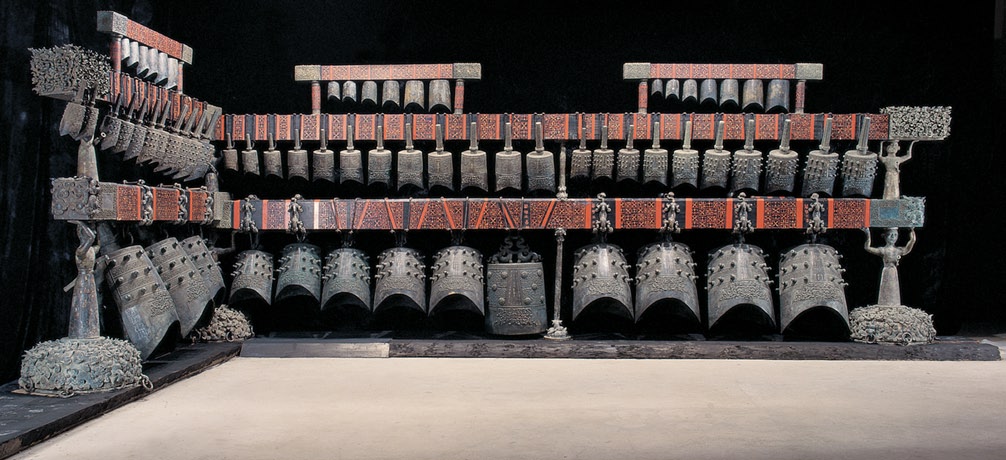Bianzhong is a musical instrument discovered in ancient china. It consists of a set of bronze bells which can be played melodically[1]. It is one of the earliest musical chimes also referred to as chime bells. They were use as instruments for polymorphic music dated between 2000 to 3600 years old[2]. They were struck with a mallet after hanging in a wooden frame. However, a different pitch can be made using a rod and a wooden harmer to hit the bronze bells. They wore discovered and used around the same as bianqing, ancient stone chimes in court music and China’s rituals in ancient times.
The oldest clapperless bells were first discovered in 2100 BCE in China. However, bianzhong organization from zhong bells was developed in the Zhou dynasty (1046–256 BCE)[3]. The number of zhongs used in this era varied between 13 and 64 where each was set to produce two set of pitches while being vertically or obliquely suspended[4]. The earliest set in China had a height of 153.4 centimeters (60.4 in) with a weight of 203.6 kilograms (449 lb) for the largest set while the smallest had a height of 20.4 centimeters (8.0 in) with a weight of 2.4 kilograms (5.3 lb)[5]. However, the construction of the instrument shifted dramatically in Tang and Qin Dynasties (221 BC – 907 BC)[6]. By the end of the Song dynasty, musicians made bianzhong one of their standard instruments. The construction remained standard throughout the Qing dynasty (1644–1911 CE)[7]. Today, the instrument is used in both Taiwan and Korea in celebrating Confucian rituals to double the melody of strings and wings- to lead the orchestra. It has also been used both at national and international levels.
Bianzhong has a leaf-shaped cross-section and a concave mouth. The overall shape slightly expands from top bottom. All sets of the instrument are suspended in a wooden frame adjacent to each other. However, the suspension is different depending on the number of chime bells. Commonly, the zhong family bells are suspended if the bell has an elongated handle. At the base of the handle is a small ring used to hang the bell at a diagonal angle. However, some of the bels are suspended by a loop in a vertical position- although is quite uncommon. There is a unique thickness for each bianzhong. This means that the size determines the pitch[8]. An individual bianzhong is very attractive and has a variety of decorative features. These might be I the form of repetitive horn-like or claw-like designs or rectangular ribs, sometimes raised slightly. Besides, some bianzhong have clustered protrusions- manly four of them. A set of 65 zhong bells used in ceremonies is the most elaborate bianzhong instrument to have been discovered[9]. It was discovered in almost perfect state as preserved in ancient times. It was discovered when Marquis Yi, an ancient tomb was excavated.
Turned bells have been used in Chinese music for many centuries. However, bianzhong bells are unique in a number of ways- the most important one being they ate lens-shaped with an enhanced cutaway profile. The bels have 36 studs, also referred to as bosses, on the exterior surface[10]. There are four groups of studs and each group has 9 studs. It is this special shape that gives the bells ability to produce two pitches depending on striking. The notes are different from one note to another is either a third or a minor. This resembles the distance of five or four notes in a piano. This gives every bell an elaborate range of tones which are good in melody playing in both pentatonic and diatonic scales. The Marquis Yi bells unearthed in 1978 have a twin-tone capability[11]. This means that they can make a 12 tone scale compete sound. Based on the fact that the instruments were invented before the European 12 tone system was developed, and that they has been buried for over 2500 years, this was a huge milestone at the time.
An analysis of the data in measured tone indicate that the melody bells (33) in the tier at the middle repeat the tome scale D-E-F-G-A-C 8 number of times[12]. Some instruments consist of a set of groups of 3 bells each that providing six tone DEFGAC[13]. This is possible since every bell has two district tones. The first bell had D_F while the second bell produces E-G. The third bell produces A-C. The sounds from the bells decay very fast since the bells were sophistically made with an octave scale in complete with three adjustment bells which allow fast playing.
The discovery of the bianzhong bells, more so the 65 Zeng bells is enough proof that more than 2500 years ago, the Chinese had already discovered the fifth temperament and fifth generation instruments. Besides, the ancient music in China was played with a complete 12-tone system. During that time, it is clear that China was about 2000 ahead of Europe in discovery of music instruments. It is the hope of many music players that a replica of Zeng bells can be made with different instruments used in playing them; for instance, a different set of mallet. Besides, more efforts might be useful in making full use of the Gamelan-like potentials in playing music.







